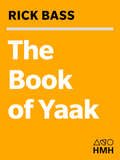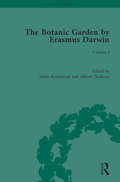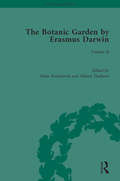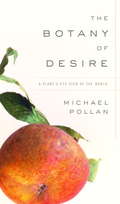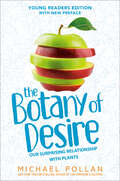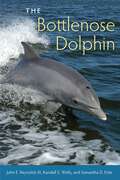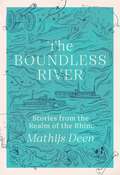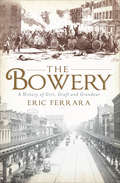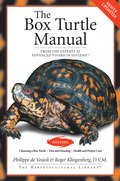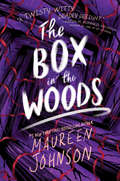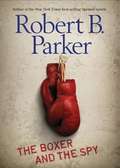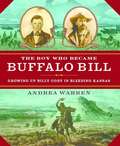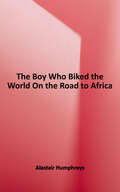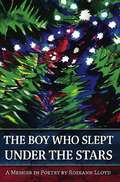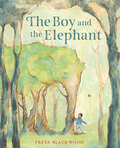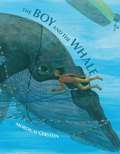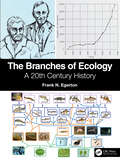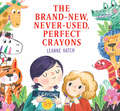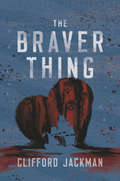- Table View
- List View
The Book of Yaak
by Rick BassThe Yaak Valley of northwestern Montana is one of the last great wild places in the United States, a land of black bears and grizzlies, wolves and coyotes, bald and golden eagles, wolverine, lynx, marten, fisher, elk, and even a handful of humans. It is a land of magic, but its magic may not be enough to save it from the forces threatening it now. The Yaak does have one trick up its sleeve, though: a writer to give it voice. In Winter Rick Bass portrayed the wonder of living in the valley. In The Book of Yaak he captures the soul of the valley itself, and he shows how, if places like the Yaak are lost, we too are lost. Rick Bass has never been a writer to hold back, but The Book of Yaak is his most passionate book yet, a dramatic narrative of a man fighting to defend the place he loves.
The Botanic Garden by Erasmus Darwin: Volume I (The Pickering Masters)
by Adam KomisarukThe career of Erasmus Darwin (1731-1802) affords an extraordinary glimpse into the intellectual ferment of late-eighteenth- and early-nineteenth-century Britain. As a popular poet, practicing physician, inventor of speaking machines and mechanical birds, essayer of natural history from geology to meteorology, and proponent of an evolutionary theory that inspired his famous grandson Charles, he left a lasting impression on almost every branch of knowledge. His magnum opus, and the synthesis of his myriad interests, is The Botanic Garden (1792) — an epic poem that aims to "enlist the Imagination under the banner of Science." Part I, The Economy of Vegetation, sings the praises of British industry as a dance of supernatural creatures while part II, The Loves of the Plants, wittily employs metaphors of human courtship to describe the reproductive cycles of hundreds of flowers. Darwin supplements his accomplished verses with (often much longer) "philosophical notes" that offer his idiosyncratic perspective on the scholarly controversies of the day. Despite a recent surge of academic interest in Darwin, however, no authoritative critical edition of The Botanic Garden exists, presenting a barrier to further scholarship. This two volume set comprises a complete, meticulously transcribed, reading text — including all the poetry, prose apparatus, and illustrations — along with extensive commentary that situates Darwin within contemporary debates about the natural sciences. This set will be of interest to readers as the definitive reference edition of The Botanic Garden and due to its efforts to make the work more practically and intellectually accessible to seasoned and novice readers alike. The first volume presents a wide ranging and authoritative introduction to The Botanic Garden, detailing the background to the work and the various contexts in which it should be understood. These include: aesthetic theory and practice, the science of the mind, love and sexuality, politics, spirituality, the natural sciences, and evolutionary theory and the two Darwins. The full text of Part I of the The Botanic Garden, The Economy of Vegetation, then follows accompanied by the editors’ annotations, discussion of illustrations and textual notes.
The Botanic Garden by Erasmus Darwin: Volume II (The Pickering Masters)
by Adam KomisarukThe career of Erasmus Darwin (1731-1802) affords an extraordinary glimpse into the intellectual ferment of late-eighteenth- and early-nineteenth-century Britain. As a popular poet, practicing physician, inventor of speaking machines and mechanical birds, essayer of natural history from geology to meteorology, and proponent of an evolutionary theory that inspired his famous grandson Charles, he left a lasting impression on almost every branch of knowledge. His magnum opus, and the synthesis of his myriad interests, is The Botanic Garden (1792) — an epic poem that aims to "enlist the Imagination under the banner of Science." Part I, The Economy of Vegetation, sings the praises of British industry as a dance of supernatural creatures while part II, The Loves of the Plants, wittily employs metaphors of human courtship to describe the reproductive cycles of hundreds of flowers. Darwin supplements his accomplished verses with (often much longer) "philosophical notes" that offer his idiosyncratic perspective on the scholarly controversies of the day. Despite a recent surge of academic interest in Darwin, however, no authoritative critical edition of The Botanic Garden exists, presenting a barrier to further scholarship. This two volume set comprises a complete, meticulously transcribed, reading text — including all the poetry, prose apparatus, and illustrations — along with extensive commentary that situates Darwin within contemporary debates about the natural sciences. This set will be of interest to readers as the definitive reference edition of The Botanic Garden and due to its efforts to make the work more practically and intellectually accessible to seasoned and novice readers alike This second volume includes the full version of the second part of The Botanic Garden, The Lives of Plants along with the related textual apparatus consisting of the editors’ annotations, discussion of the illustrations, textual notes, and a taxonomic table of the flowers mentioned.
The Botany of Desire: A Plant's-Eye View of the World
by Michael PollanThe book that helped make Michael Pollan, the New York Times bestselling author of Cooked and The Omnivore’s Dilemma, one of the most trusted food experts in AmericaIn 1637, one Dutchman paid as much for a single tulip bulb as the going price of a town house in Amsterdam. <P><P>Three and a half centuries later, Amsterdam is once again the mecca for people who care passionately about one particular plant—though this time the obsessions revolves around the intoxicating effects of marijuana rather than the visual beauty of the tulip. <P>How could flowers, of all things, become such objects of desire that they can drive men to financial ruin? <P>In The Botany of Desire, Michael Pollan argues that the answer lies at the heart of the intimately reciprocal relationship between people and plants. <P>In telling the stories of four familiar plant species that are deeply woven into the fabric of our lives, Pollan illustrates how they evolved to satisfy humankinds’s most basic yearnings—and by doing so made themselves indispensable. <P>For, just as we’ve benefited from these plants, the plants, in the grand co-evolutionary scheme that Pollan evokes so brilliantly, have done well by us <P>. The sweetness of apples, for example, induced the early Americans to spread the species, giving the tree a whole new continent in which to blossom. So who is really domesticating whom? <P>Weaving fascinating anecdotes and accessible science into gorgeous prose, Pollan takes us on an absorbing journey that will change the way we think about our place in nature.
The Botany of Desire: Our Surprising Relationship with Plants
by Michael PollanBy the author of The Omnivore's Dilemma, this is Michael Pollan's ingenious companion book about the surprising and close relationship between people and plants. <P><P> In this entertaining young readers edition of the environmental studies classic, Michael Pollan demonstrates how people and domesticated plants have formed a reciprocal relationship. He links four fundamental human desires—sweetness, beauty, energy, and control—with the plants that satisfy them: the apple, the tulip, coffee, and the potato. In telling the stories of four familiar species, Pollan illustrates how the plants have evolved to satisfy humankind’s most basic yearnings. And just as we’ve benefited from these plants, we have also helped them to thrive. <P><P> The Botany of Desire is perfect for STEM-focused young readers who want to learn more about: human history, biology, and environmentalism; climate change and its impact on our relationship with plants; and gardening and the human-plant relationship.
The Bottlenose Dolphin: Biology and Conservation
by Randall S. Wells John E. Reynolds III Samantha D. EideThe Bottlenose Dolphin presents for the first time a comprehensive, colorfully illustrated, and concise overview of a species that has fascinated humans for at least 3,000 years.After reviewing historical myths and legends of the dolphin back to the ancient Greeks and discussing current human attitudes and interactions, the author replaces myths with facts--up-to-date scientific assessment of dolphin evolution, behavior, ecology, morphology, reproduction, and genetics--while also tackling the difficult issues of dolphin conservation and management.Although comprehensive enough to be of great value to professionals, educators, and students, the book is written in a manner that all dolphin lovers will enjoy. Randall Wells’s anecdotes interspersed throughout the work offer a first-hand view of dolphin encounters and research based on three decades working with them. Color photographs and nearly 100 black and white illustrations, including many by National Geographic photographer Flip Nicklin, beautifully enhance the text.
The Boundless River: Stories from the Realm of the Rhine
by Mathijs Deen"A beautiful book, by turns poetic, witty and full of learning . . . This unique biography of a river marks a new kind of writing about people and place, both in and out of time" PATRICK McGUINNESSThe Boundless River takes the reader into a unique world ‒ the twilight zone between fact and fiction, science and imagination ‒ and on a journey which moves effortlessly from a time in prehistory, long before the existence of a European continent, to the present day. Along the way Deen encounters paleontologists, geologists, museum curators, taxidermists, fishermen and skippers who work the boats, who still see the Rhine as a living entity.From the mighty hippos that swam in its waters millions of years ago, to the weary salmon that saw their habitat slowly change and the aurochs that grazed its shores; from the primordial Steinheim Woman to the Roman general Corbulo who commanded settlements along its delta, to a young Goethe: in all of their stories the Rhine is ever present, sometimes as the main character, sometimes as an extra, as a theatre of war, a border between nations, a bathing spot, a killer, a vital transport route.Beautifully fluid, rich and captivating, The Boundless River shows how the Rhine connects and divides, terrifies, comforts, carries and swallows, and has done since the beginning of time.Translated from the Dutch by Jane Hedley-Prôle and Jonathan Reeder
The Bowery: A History of Grit, Graft and Grandeur
by Eric FerraraThe cultural and criminal history of downtown Manhattan comes to life in this far-reaching exploration of a legendary street. Originally a Lenape trail running the length of Manhattan Island, The Bowery has become one of the most notorious streets in America. Developed in stages by the Dutch, the British, and then Americans, this stretch of street has continually risen from its own ashes, experiencing a seemingly endless cycle of popularity, poverty and prosperity. The Bowery has been celebrated as a haven of culture, entertainment, and theatre. But is has just as often been denigrated as New York's "skid row." Home to bums, bohemians, criminals, artists, performers, and the rich and poor alike, The Bowery has attracted the most diverse population of any place in New York City's history. Travel down the Bowery with New York City historian Eric Ferrara, as he explores its rich, fascinating, and at times, troubling past.
The Box Turtle Manual
by Philippe De Vosjoli Roger J. KlingenbergThe Box Turtle Manual seeks to "help prospective owners keep their turtles healthy and happy." Given the low price tag placed on a box turtle in a pet shop, many casual shoppers add a box turtle to their household without preparation or knowledge about how to keep the animal alive. Since quality information is difficult to find on box turtles, Philippe de Vosjoli and Dr. Roger Klingenberger remedy the situation with this Advanced Vivarium Systems edition dedicated to box turtles. The authors believe that these popular and beautiful turtles...."may teach you one or two lessons about the delicate balance of life, natural law, and the many ways in which intelligence in manifested in nature." The book presents background information and guidelines for caring for a box turtle, including selecting a health specimen, acclimating the turtle, indoor and outdoor housing, heating and lighting requirements, feeding and handling, hibernation and breeding. The authors recommend three specific species of box turtles as good pet candidates: they provide photos and information on ornate box turtles, common Asian box turtles, and Chinese box turtles. Dr. Klingenberger provides a chapter on diseases and disorders that gives specific advice about dealing with dehydration, nutritional problems, parasitic problems, and vitamin deficiency. A five-page troubleshooting chart for health problems concludes the chapter. Resources and index included.
The Box in the Woods (Truly Devious Ser. #4)
by Maureen JohnsonAfter solving the case of Truly Devious, Stevie Bell investigates her first mystery outside of Ellingham Academy in this spine-chilling and hilarious stand-alone mystery from New York Times bestselling author Maureen Johnson. <P><P>Amateur sleuth Stevie Bell needs a good murder. After catching a killer at her high school, she’s back at home for a normal (that means boring) summer. <P><P>But then she gets a message from the owner of Sunny Pines, formerly known as Camp Wonder Falls—the site of the notorious unsolved case, the Box in the Woods Murders. Back in 1978, four camp counselors were killed in the woods outside of the town of Barlow Corners, their bodies left in a gruesome display. The new owner offers Stevie an invitation: Come to the camp and help him work on a true crime podcast about the case. <P><P>Stevie agrees, as long as she can bring along her friends from Ellingham Academy. Nothing sounds better than a summer spent together, investigating old murders. <P><P>But something evil still lurks in Barlow Corners. When Stevie opens the lid on this long-dormant case, she gets much more than she bargained for. The Box in the Woods will make room for more victims. This time, Stevie may not make it out alive. <P><P>* Cosmopolitan Best YA Books of 2021 <P><P>* People Magazine Best Books of Summer 2021* <P><P><b>A New York Times Best Seller</b>
The Boxer and the Spy
by Robert B. ParkerAnother teen thriller from the New York Times bestselling author of the Spenser mysteries. When a shy high school student?s body is found washed up on the shore of a quiet New England beach town?an apparent suicide?fifteen-year-old Terry Novak doesn?t know what to think. Something just doesn?t add up, so he decides to do some investigating of his own with the help of his best friend, Abby. It doesn?t take long before they learn that asking questions puts them in grave danger, and surviving is going to be a fight. Fortunately, Terry has been learning a thing or two about fighting, thanks to a retired boxer named George, who teaches the boy to use his head and always keep his feet set beneath him?lessons Terry takes to heart in more ways than one. He will need to. Robert B. Parker, New York Times bestselling author of the Spenser novels, delivers a taut, empowering mystery for young readers. .
The Boxer and the Spy
by Robert B. ParkerWhen a shy high school student's body is found washed up on the shore of a quiet beach town - an apparent suicide - Terry Novak doesn't know what to think. He decides to do some investigating with the help of his best friend, Abby. Before long, they learn that asking questions puts them in grave danger. Fortunately, Terry has been learning about fighting, thanks to a retired boxer, who teaches him to use his head and keep his feet set beneath him - lessons Terry takes to heart in more ways than one. Robert B. Parker delivers a taut, empowering mystery for teen readers.
The Boy Scout Handbook 13th Edition
by Boy Scouts of America StaffBoy Scouts learn an amazing number of things about camping, nature, first aid, and more. The Scout Oath, Scout Law, Scout motto, and Scout slogan will guide your steps long after you hang up your hiking boots.
The Boy Who Became Buffalo Bill: Growing Up Billy Cody In Bleeding Kansas
by Andrea WarrenThe greatest entertainer of his era, Buffalo Bill was the founder and star of the legendary show that featured cowboys, Indians, trick riding, and sharpshooters. But long before stardom, Buffalo Bill—born Billy Cody—had to grow up fast. While homesteading in Kansas just before the Civil War, his family was caught up in the conflict with neighboring Missouri over whether Kansas would enter the Union as a free or slave state. To support his family after a pro-slaver killed his father, Billy—then eleven—herded cattle, worked on wagon trains, and rode the Pony Express. As the violence in Bleeding Kansas escalated, he joined the infamous Jayhawkers, seeking revenge on Missourians, and then became a soldier, scout, and spy in the Civil War—all by age seventeen. Award-winning author Andrea Warren brings to life the compelling childhood of an adventurous, determined boy who transformed himself into a true American icon.
The Boy Who Biked the World: Part One: On the Road to Africa
by Alastair HumphreysAges 9 – 12 years Discover Africa by bicycle in book 1 of a delightful children's adaptation of Alastair Humphrey's journey around the world. In this charming caricature of Alastair Humphreys' infamous circumnavigation of the world on his bike, children are swept along with the character of Tom, an adventurous boy who feels there must be more to life than school. The first part of The Boy Who Biked the World follows Tom leaving England, cycling through Europe, and Africa to the tip of South Africa. Along the way, young readers are introduced not only to the various fascinating landscapes he passes through, but also to the various people who so happily embrace him as he traveled on his journey. With engaging illustrations, postcards, and journal entries throughout, this book provides an immersive experience for any young adventurer.
The Boy Who Harnessed the Wind: Young Readers Edition
by William Kamkwamba Bryan Mealer Anna HymasNIMAC-sourced textbook
The Boy Who Slept Under the Stars
by Roseann Lloyd"This a book about that place inside us all where bafflement meets mystery: a strange place, sometimes frightening and sometimes filled with stars and pines, clear flowing water and the deep joy of companionship."--Jim Moore Roseann Lloyd's new poetry collection takes us on a sister's unflinching exploration into grief for a brother lost on a solo hike in the Boundary Waters Canoe Area Wilderness in northern Minnesota. His clothes are found but not his body. How does one mourn without a body? This absence calls up memories of his life and mixed emotions; it evokes other disappearances--children missing in Iraq, climbers lost on Everest, a college student drowned. Even though I've said, for two years now, I don't need his bodyto do my mourning, I'm suddenly desperateto touch your arms, muscled and tan . . . Full of verbal energy and rich patterns of sound, Lloyd's lines are allowed to breathe and move about in always interesting forms: prose poems, found poems, section poems, swirling mosaics of time and place. Beautifully crafted, the poems are emotionally complex yet accessible. Roseann Lloyd has published eight books, including three poetry collections: Because of the Light (Holy Cow! Press), War Baby Express (Holy Cow! Press--awarded the Minnesota Book Award for Poetry), and Tap Dancing for Big Mom (New Rivers Press). The anthology she co-edited with Deborah Keenan, Looking for Home: Women Writing About Exile (Milkweed Editions) was awarded an American Book Award. She lives in Minneapolis, Minnesota.
The Boy and the Elephant
by Freya BlackwoodFrom an award-winning illustrator comes a tender, magical, and gorgeously rendered wordless picture book about a boy who saves the trees in the lot next door from being cut down.Amongst the hustle and bustle of the city is an overgrown piece of land where trees and wildlife thrive. A boy, who lives in a house on the lot next to it, loves to visit. He has a friend there: an elephant, an animal that he sees within the shapes of the trees. No matter the weather, the boy visits. And as the seasons change so does the elephant; thick green foliage changes to autumnal colors before the bare branches of harsh winter appear. But one day, builders arrive. The land has been sold, and the trees have been marked for removal. The boy can't lose his elephant, and so he comes up with a plan.Unbearably beautiful and moving, and with a touch of magical realism, here is a wordless picture book about conservation and children's ability to be powerful agents of change.
The Boy and the Mountain
by Mario BelliniA boy sets off to draw a mountain in this thoughtful exploration of art and the creative process. For fans of Hike by Pete Oswald.A little boy, who is a keen artist, becomes obsessed with a mountain he can see from his house. One day, he tries to draw the mountain, but his drawing doesn't look anything like it, so he decides that he has to take a closer look. He sets off with his dog, drawing what he sees along the way, and making a growing collection of animal companions during his hike. But when he finally reaches the mountain, the boy makes a discovery about the importance of perspective and friendship which changes how he views the world around him.Both a powerful exploration of art and a sweet ode to hiking, this picture book from acclaimed author-illustrator Marianna Coppo and her partner, Mario Bellini, will inspire readers young and old to stop and take the time to appreciate both the world around them and others who inhabit it.
The Boy and the Whale
by Mordicai GersteinA boy and his father discover a whale tangled in their only fishing net. Is the whale dead? While the man worries about losing their net, the boy worries about the whale. He remembers the fear he felt when, caught in a net himself in childhood, he almost drowned before being rescued by his father. When the whale blinks an enormous eye, the boy knows that he has to try to save the creature, no matter how dangerous doing so may be. Expressive and perfectly paced, this powerful story, The Boy and the Whale, by Caldecott Medal–winner Mordicai Gerstein was inspired in part by a real-life video of a whale’s rescue, and the creature’s joyful dance through the waves after being freed.
The Boys in the Cave: Deep Inside the Impossible Rescue in Thailand
by Matt GutmanFrom award-winning ABC News Chief National Correspondent Matt Gutman, and written using exclusive interviews and information comes the definitive account of the dramatic story that gripped the world: the miracle rescue of twelve boys and their soccer coach trapped in a flooded cave miles underground for nearly three weeks—a pulse-pounding page-turner by a reporter who was there every step of their journey out. After a practice in June 2018, a Thai soccer coach took a dozen of his young players to explore a famous but flood-prone cave. It was one of the boys’ birthday, but neither he nor the dozen resurfaced. Worried parents and rescuers flocked to the mouth of a cave that seemed to have swallowed the boys without a trace. Ranging in age from eleven to sixteen, the boys were all members of the Wild Boars soccer team. When water unexpectedly inundated the cave, blocking their escape, they retreated deeper inside, taking shelter in a side cavern. While the world feared them dead, the thirteen young souls survived by licking the condensation off the cave’s walls, meditating, and huddling together for warmth.In this thrilling account, ABC News Chief National Correspondent Matt Gutman recounts this amazing story in depth and from every angle, exploring their time in the cave, the failed plans and human mistakes that nearly doomed them, and the daring mission that ultimately saved them. Gutman introduces the elite team of volunteer divers who risked death to execute a plan so risky that its American planners admitted, “for us, success would have meant getting just one boy out alive.” He takes you inside the meetings where life and death decisions were grimly made and describes how these heroes pulled off an improbable rescue under immense pressure, with the boys’ desperate parents and the entire world watching. One of the largest rescues in history was in doubt until the very last moment. Matt Gutman covered the story intensively, went deep inside the caves himself, and interviewed dozens of rescuers, experts and eye-witnessed around the world. The result is this pulse-pounding page-turner that vividly recreates this extraordinary event in all its intensity—and documents the ingenuity and sacrifice it took to succeed.
The Branches of Ecology: A 20th Century History
by Frank N. EgertonThe ecological sciences are a diverse array of major scientific disciplines. They grew from minor sciences, with little status in 1900, and now occupy crucial areas of research bearing on the future of our planet. This book describes a century of growth and development. A dramatic century-long rise in the status of ecological knowledge was accompanied by the rise of professional ecological organizations, the establishment of university faculties, and the creation of government agencies advising on conservation, natural resources, and the prevention of pollution. Like all sciences, ecology continues to yield new findings and surprising revelations. New technologies now address existential challenges facing our world. This book, documenting the rise of ecology, is an inspiring history portending an important role in the twenty-first century.Key Features: The author is the acknowledged authority on the history of ecology The content is familiar to members of the Ecological Society of America but has not previously been assembled into a single narrative Appropriate for a course in the history of ecology Provides a broad perspective on ecology Related Titles:Egerton, F. N. A Centennial History of the Ecological Society of America (ISBN 978-0-3673-7763-2).Rieppel, O. Phylogenetic Systematics: Haeckel to Hennig (ISBN 978-0-3678-7645-6)Dronamraju, K. A Century of Geneticists: Mutation to Medicine (ISBN 978-1-4987-4866-7)
The Brand-New, Never-Used, Perfect Crayons
by Leanne HatchNothing is better than a brand new box of crayons. Violet loves hers so much that she refuses to share them--or even to use them-- but maybe her little sister is on to something . . .Violet is ecstatic when she earns her very own super big box of eighty-four crayons all matching in length, perfectly pointed, each in their smooth, uniform wrapper. There&’s even one with her name on it. She can&’t stop imagining all the wonderful things she can draw with them.But when it comes time to get busy, she can&’t seem to do it—she doesn&’t want to ruin all that perfection. It isn&’t until her little sister takes matters into her own hands that Violet is able to let go and have fun drawing all the things she dreamed up when she first got her box of brand-new, never-used, perfect crayons.With The Brand-New, Never-Used, Perfect Crayons, Leanne Hatch taps into the joy of sharing, creating, and letting go of perfectionism. Adorable art set alongside textured crayon sketches reminiscent of classics like Harold and the Purple Crayon makes this a book perfectly suited for the shelves of young creatives everywhere. A Junior Library Guild Gold Standard Selection
The Braver Thing
by Clifford JackmanFrom the acclaimed author of The Winter Family, a swash-buckling adventure from piracy's Golden Age and a deft political allegory for our troubled times. Treasure Island meets Lord of the Flies.In 1721, when the most notorious pirates are either dead or on the run, Jimmy Kavanagh, who sailed with Blackbeard, decides to pull together a "Company of Gentleman of Fortune" for one last "Adventuring Cruise" that will set them all up for life. All begins well: the pirates sail across the Atlantic and sack Cape Coast Castle, looting it of chests of gold ill-gotten from the slave trade. But before Kavanagh can lead them on, he sickens, unleashing a drastic series of power struggles among the company. As further victories transform them from the hunters to the hunted, the pirates descend into mutiny, show trials, assassination and tyranny as they flee from their pursuers and struggle against the seas. Full of epic sea battles and storms, peopled with characters worthy of Mutiny on the Bounty, Jackman's pirate voyage is also an object lesson in how political systems degrade as the pirates, who set out as a band of brothers, are powerless to prevent the erosion of the norms and values that hold their Company together. Where they end will shock you. But given our own times, it might not surprise you.
The Brazilian Amazon
by Joana BezerraThe aim of this book is to analyse the current development scenario in the Amazon, using Terra Preta de Índio as a case study. To do so it is necessary to go back in time, both in the national and international sphere, through the second half of the last century to analyse its trajectory. It will be equally important analyse the current issues regarding the Amazon - sustainable development and climate change - and how they still reproduce some of the problems that marked the history of the forest, such as the absence of Amazonian dark earths as a relevant theme to the Amazon. In a world in which the environment gains each time more space in the national and international political agenda, the Amazon stands out. Known around the world for its richness, the South-American forest is the target of different visions, often contradictory ones, and it plays with everyone's imagination. This is where the terra preta de índio - Amazonian Dark Earths - are found, a fertile soil horizon with high concentrations of carbon with anthropic origins, which has generated great interest from the scientific community. Studies on these soils and their so singular characteristics have triggered crucial discussions on the past, present and the future of the entire Amazon region. Despite its singular characteristics, the importance of Amazonian Dark Earths - and a history of a more productive and populated Amazon - was hidden since its discovery around 1880 until 1980, when it is possible to identify the beginning of an increase in the number of research on these soil horizons. These hundred years between the first records and the beginning of the increase in the interest around these soils witnessed structural changes both in the national arena, with the military dictatorship and a change in the place of the Amazon within internal affairs, and in the international arena with changes that reshaped the role of the environment in the political and scientific agendas and the role of Brazil in the global context.
